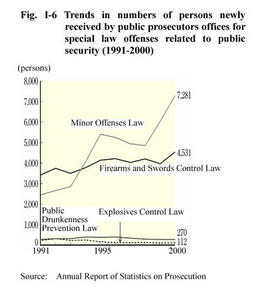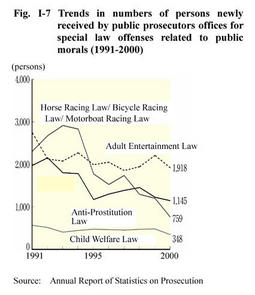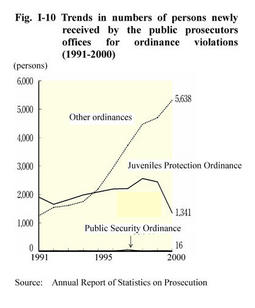| Previous Next Index Image Index Year Selection | |
|
|
2. Trends in major special law offenses In this subsection, we will examine the trends in major special law offenses, excluding those described later:financial and economic offenses (Section 3); election-related offenses (Section 4); traffic offenses (Part 4); drug offenses (Part 4); and foreigner-related offenses (Part 4) (see Appendix I-4 ).
Figures I-6 to I-10 show the trends in the number of persons newly received by public prosecutors offices for special law offenses related to public security, public morals, the environment and labor as well as violations of ordinances over the last decade or two decades. With respect to offenses related to public security, the number of Minor Offenses Law violations continued to show a sharp rise, reaching the highest point in 2000 in the last ten years. Viewing the nature of violations for which a large number of persons are referred, the following violations are observed:for Firearms and Swords Control Law violations, carrying a knife, aggravated possession of a pistol, etc. and illegal possession of a pistol, etc. ; for Minor Offenses Law violations, removal of bills or markers, carrying an offensive weapon and trespassing on crop fields, etc. ; and for Explosives Control Law violations, conveyance and receipt, possession and storage (according to Criminal Statistics by the National Police Agency). Conventionally, stalking was treated as a Minor Offenses Law violation within the scope of special law offenses or an intimidation within the scope of penal code offenses. The Anti-Stalking Law (Law No.81 of 2000) was enacted on May 24 and came into force in November 2000. The law allows a prefectural public safety commission to establish a system that gives an order to prohibit a person from stalking (repeated acts including following the same person about because of a feeling of love, etc. ), and to punish persons who violate the order and commit stalking. The number of persons newly received by public prosecutors offices for violations of this law in 2000 was 18 (according to the Annual Report of Statistics on Prosecution). The number of offenses related to public morals decreased from the previous year for almost all types of such offenses in 2000, and the number for Child Welfare Law violations, which had leveled off at around 450 persons since 1994, also decreased by 133 persons over the previous year. There was also a sharp decline in the number of Horse Racing Law and Motorboat Racing Law violations. Viewing the number of persons referred by the nature of violations, more frequent Anti-Prostitution Law violations included soliciting, enticement, and provision of locale, etc. and the most common Child Welfare Law violation was coercing minors into sexual acts (according to the Criminal Statistics by the National Police Agency). Although there has been a general declining trend in the number of overall special law offenses related to the environment, the number of Wastes Disposal Law violations started to increase rapidly in 1997, and continued to show an upward trend, though with signs of a reduction in the rate of increase. In 2000, it increased by 102 persons over the previous year. The number of persons newly received by public prosecutors offices over the last two decades has been generally decreasing for all types of offenses except for Wastes Disposal Law violations. After alternating between increases and decreases since 1989, the number for Wastes Disposal Law violations showed a sharp upward trend in 1997, as mentioned above. It has been hitting new post-1989 highs each year over the last three years, nearly forming its second peak. As for labor-related offenses, while the number of Worker Dispatch Law violations showed a sharp decline after reaching a peak in 1997, the number of Industrial Safety and Health Law violations changed to a slight upward trend after showing a downward trend, and the number of Labor Standards Law violations continued an upward trend. With respect to violations of ordinances, the number of violations of the Juveniles Protection Ordinance, which had been in an increasing trend since 1993, started to decrease from 1999 when the Law for Punishing Acts Related to Child Prostitution and Child Pornography, and for Protecting Children came into force. It is because the acts that came under the new law could not be punished as ordinance violations. Fig. I-6 Trends in numbers of persons newly received by public prosecutors offices for special law offenses related to public security (1991-2000) I-7 Trends in numbers of persons newly received by public prosecutors offices for special law offenses related to public morals (1991-2000) Fig. I-8 Trends in numbers of persons newly received by the public prosecutors offices for special law offenses related to the environment (1981-2000) Fig. I-9 Trends in numbers of persons newly received by the public prosecutors offices for special law offenses related to labor (1991-2000) Fig. I-10 Trends in numbers of persons newly received by the public prosecutors offices for ordinance violations (1991-2000) |




